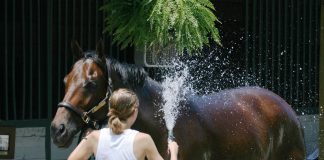Just as with humans, there are risks when a horse goes under general anesthesia. Fortunately, this is where some of the greatest advances in equine surgery have been in the past decade.
“The risk of anesthesia depends upon a number of factors, generally affecting the physical condition of the horse,” explains Patrick T. Colahan, DVM, DACVS, a board-certified surgeon, large animal surgery specialist, professor and chief of staff of the Large Animal Hospital at the University of Florida. “The presence of shock and the severity of the shock, the soundness of the animal’s limbs, the presence of neurological problems, and the presence of some genetic conditions like HYPP (Hyperkalemic Periodic Paralysis) will increase the risk of problems–potentially catastrophic problems–occurring during anesthesia or during recovery.”
Conditions that can put the horse at greater risk than normal are usually predictable from the physical examination of the horse, or from the medical history and knowledge of the breed, Colahan adds.
When a horse goes in for surgery, a breathing tube is inserted into the windpipe. A gas anesthetic is routinely used to put the horse “under” and is sometimes combined with an injectable anesthetic administered intravenously.
The horse will often be given 100 percent oxygen while under anesthesia. During surgery and while coming out of anesthesia, the horse’s heart rhythm and blood oxygen content are closely monitored.
“To bring a horse out of anesthesia, we stop administering the gas and just keep giving the oxygen,” Colahan says. “Tranquilizers and sedatives are added to make the transition from anesthesia easier for the horse.”
Any time a horse is admitted for surgery, the owner must sign a consent form acknowledging the risks. In the case of elective surgery, blood tests are performed to make sure the horse is healthy and doesn’t have any medical issue going on that might complicate the anesthesia scenario.
With a healthy horse, the risks of anesthesia are minimal, but still present. The horse’s age and physical condition are important. Anesthesia is harder on horses in their twenties. A fit horse in good condition is typically at less risk than a horse in poor body condition. Pregnant mares gain weight and lose calcium from their bones during pregnancy, which puts them at greater risk for injury when they recover from anesthesia. In addition, post anesthesia problems may include pneumonia and diarrhea.
While many problems can be speculated, not all can be foreseen. “Totally unknown or unpredictable things can occur, such as adverse drug reactions or a broken leg due to a misstep during recovery,” Colahan says. “The severity of complications varies from minor to catastrophic and terminal. In general, post anesthesia problems are uncommon and catastrophic problems are rare, even considering age and infirmity of the patients, but problems do occur.”





